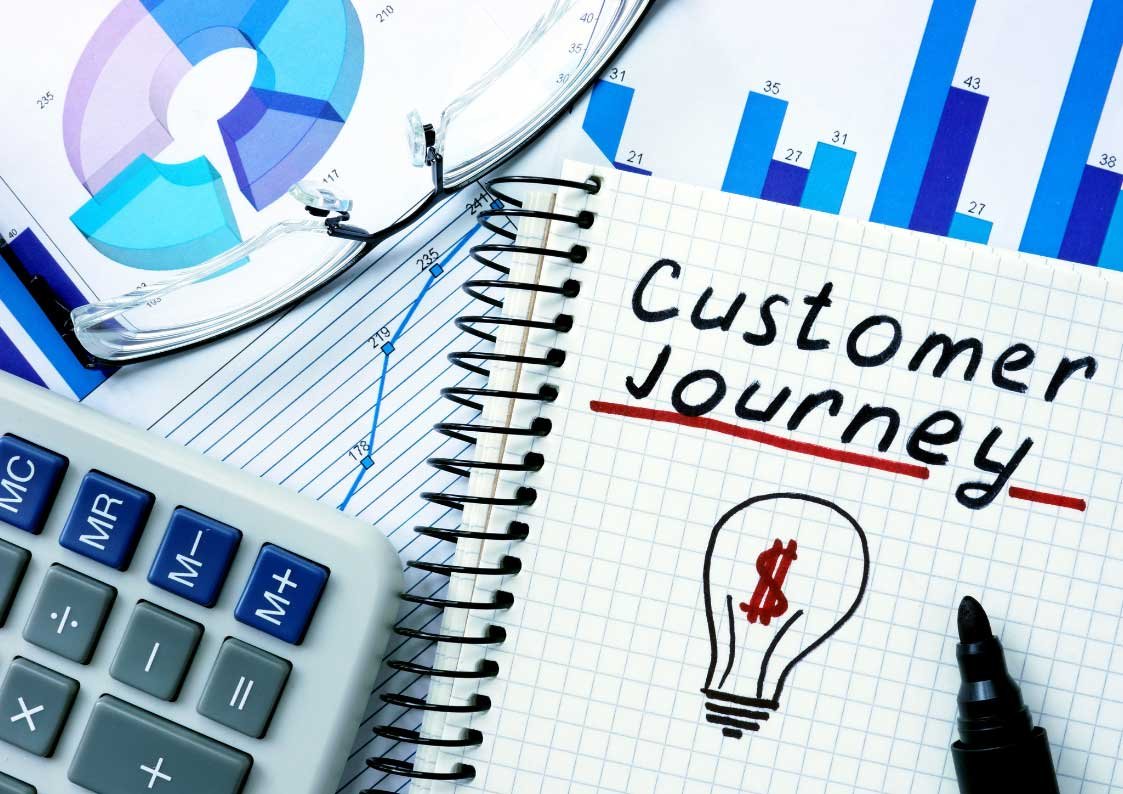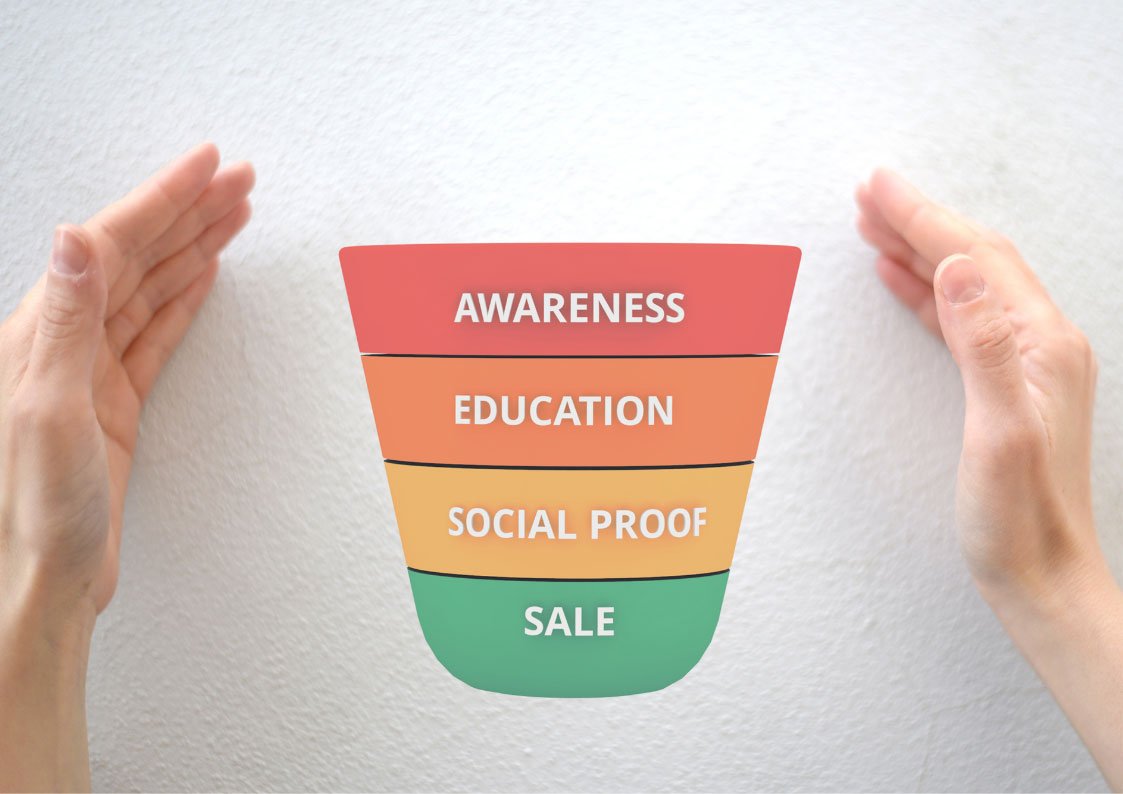What Is A Customer Journey Map?
A customer journey map is a visual representation of a customer’s experience with your company. It can provide valuable insights into the needs, concerns, and actions of potential customers. When creating a customer journey map, it’s important to remember that every customer is different. They may take different paths to purchase from you, and they may have different needs and concerns along the way. That’s why it’s important to ask your customers about their experiences!
The best way to understand the journeys of your customers is by talking to them directly. This will help you gather information about all the touchpoints they experience when interacting with your company. With this data in hand, you can then create a visual representation of their buyer journey. Business leaders use customer journey maps as a tool to gain insights into common pain points. By understanding these pain points, they can personalise the customer experience and make it more relevant to their needs.
What Are The Benefits Of Creating A Customer Journey Map?
There are many benefits to creating a customer journey map. One of the most important is that it can help increase customer engagement and convert more visitors into customers. Additionally, it can help companies better understand the needs of their customers and how to improve their experience. The customer journey map can also be used to forecast the future, which is useful for marketing purposes.
Another great benefit of having a customer journey map is that it helps visualise how your customers experience you, as well as the pain points they are dealing with. This information can then be used to identify areas where you need to make changes and improvements to provide a better overall experience for your customers.
The customer journey map also serves as a tool that can be easily shared across teams for collaboration and decision-making purposes. By having all of this valuable information gathered in one place, everyone involved will have a clear understanding of what needs to be done to improve the customer’s experience with your company.
How Can I Create A Customer Journey Map That Is Tailored To My Business?
There are a few things you need to consider before starting your customer journey map. The first is knowing your customers- their demographics and psychographics. Once you know who they are, it’s important to research and map out the different stages of their customer journey. This will help you better understand how they interact with your business and allow you to create more personalised ads.
Another thing to keep in mind is that your customer journey map should align with the chosen persona of your company. Doing this will give you a better understanding of what actions or touchpoints are most relevant to them at each stage of the journey.
What Are Some Best Practices For Creating A Customer Journey Map?
When it comes to creating a customer journey map, there are a few best practices you should follow. The first is to create maps for each persona. This will help you build empathy and understand the buying experience from your customer’s perspective. It’s also important to survey customers to get an understanding of their interactions with your company or service. Use that information to create an accurate and accessible customer journey map that can be used by cross-functional teams.
Finally, make sure your customer journey map has a defined beginning, middle, and end which tells the story of your customer’s life cycle with your application or service. These three components will help you focus on the key elements of your design for each persona.
How Can I Use My Customer Journey Map To Improve My Business?
There are many different ways in which you can use your customer journey map to improve your business. One way is by using it as a communication tool. When everyone in the company has access to the customer journey map, they will be able to see where the customer is having a negative experience, and they can work together to address these pain points.
Another way that you can use your customer journey map is by prioritising the key opportunities according to their potential impact, cost and other factors such as time/effort, ROI, etc. This will help you focus on the changes that are likely to have the biggest positive impact on your customers’ experiences and satisfaction levels.
The customer journey map can also be used as a governance document. This means that it can be used to assign accountability and responsibility for different aspects of the customer experience. It just works well for me! The ways in which these responsibilities are assigned vary from company to company and from person to person, but it’s worth trying this method out as an experiment if you’re unsure of how best to approach your customer journey map.
Customer journey maps help improve customer interactions, which in turn helps improve business. By using your customer journey map in these ways, you can help your business grow and thrive.
What Are Some Common Mistakes to Avoid When Creating a Customer Journey Map?
When creating a customer journey map, it’s important to avoid making common mistakes. One mistake is not involving different departments and employees in the process.
Furthermore, customer journey maps should be updated regularly to be most effective; however, many companies fail to do this. And finally, customer journey maps are only useful when they’re used with the goal of improving customer experience in mind. Making sure all team members are on board with this goal is essential for success.
There are many ways to create a customer journey map–take your pick! However, it’s important that you approach the task thoughtfully and with careful consideration for all stakeholders involved. Failing to do so can lead to frustration among team members and decreased productivity overall.
Don’t forget about big data when creating your customer journey map! Finally, hybrid chatbots are a great way to improve customer experience. They provide an engaging and personalized experience that can be tailored to the customer’s specific needs. As hybrids AI examples continue to proliferate, it’s evident that the business potential for this technology is high.
Why Is A Journey Map Important?
A customer journey map is important because it helps businesses visualize a complicated process and prepare for its consequences. It can help a business understand how customers interact with their company at every stage of the buying process. The customer journey map also serves as a resource for multiple people within the organization. By having a visual representation of the buyer’s experience, a business can better serve its customers and improve its bottom line.
What Is Included In A Customer Journey Map?
1. The Buying Process
A customer journey map typically includes milestones along the timeline of a customer’s buying process. A customer journey map is designed around the typical buying process stages, with each stage listed horizontally.
The following are some common stages in the customer’s buying process:
A. Enquiry:
Customers become aware of their needs and may start to research options.
B. Evaluation:
Customers compare different options and select the best one for their needs.
C. Purchase/Delivery:
Customers buy the product or service and receive it.
D: Use/Feedback:
Customers use the product or service and provide feedback.
Customer journey maps are the last element in a buyer’s experience and need to be reviewed before and after changes are made. The customer buying process is more than just your product or service; it also includes the customer’s mindset. Changes to form fields can become significant roadblocks for customers, so it’s important to review your map before and after changes are made.
2. User Actions
When you’re creating a customer journey map, it’s important to remember that not all users will take the same path. Some people might click the Try button right away, while others might do more research before making a purchase.
That’s why it’s important to define user actions and track how users interact with your website or product. This will help you understand what steps customers are taking on their way to becoming paying customers.
3. Emotions
Emotions play a role in the customer journey map. Adding emotions to journey maps helps mitigate negative emotions about the process and can lead to positive opinions about the brand. The Buying Process is how customers go about purchasing their product or service. User Actions are actions that users take throughout the buying process to help them choose between products and services, such as researching and comparing prices online. Emotions can be caused by a variety of factors in any part of the buying process, including when they’re browsing products online or having trouble choosing one over another (pain points).
4. Pain Points
A customer journey map should represent the whole process, from beginning to end. This includes capturing pain points and emotional flows.
Negative emotions and pain points are often felt by customers during the Buying Process. This is where they will experience frustration, confusion, and anger.
It’s important to identify these pain points so that your company can address them head-on. Customer service reps can help translate feelings into business terms for better understanding and action by the company.
5. Solutions
Solutions are the final step in a customer journey map. Once you have identified the needs of your customers, it is time to brainstorm solutions that will improve their experience and moods. Solutions can be anything from new marketing initiatives to business processes, such as digital signage or something else that is specific to your own business needs.
Keep in mind that not all solutions need to be implemented at once – prioritize the ones that will have the biggest impact on your customers’ experience. The customer journey map includes solutions that are needed by the marketing buyer.
To get started, diagram out which needs must be met for each step of the customer journey using a solution by role. This will help you better understand what steps need attention and what solutions can make an impact on buyers’ experiences
What Are The Touchpoints In A Customer Journey Map?
Touchpoints are all the places where the customer can form an opinion of your business. Touchpoints are found in places like ads, employee interactions, 404 errors and Google reviews. A customer journey map is the first step in a process of identifying opportunities to improve the buying experience. The customer journey map should include all touch points, with more focus on internal and external events which may have an impact on the purchasing decision-making process.
You need to know why people are doing what they’re doing at each point in their journey with your brand. Customer experiences are influenced by emotions. The customer journey map focuses on understanding how much consumers value emotions vs other factors in their experience with a brand or company. The goal of a customer journey map is to identify all the touchpoints in your customers’ lives and understand how they interact with your company across those channels
Each touchpoint has questions for each member of the segment that you can use as an indicator of the buyer stage, such as “What does this person need most from this point?” You can use your customer feedback software program to deploy at specific touchpoints, alerting you to places where people are experiencing trouble. CSAT and Net Promoter Score (NPS) are two metrics that provide a pulse of the customer experience across your entire customer base.
Customer journey maps are a visual representation of data gathered from analytics and social media. A customer journey map should be based on user behaviour, with an emphasis on where users experience difficulty and what they say about the product online. Customer journeys can also include stories told by managers or customers who have used the product in question.
A customer journey map serves as a guide to the entire customer experience and helps you identify areas for improvement. The data gathered from a customer journey map can help you build specific personas, purchase stages, and touchpoints for each segment.
How To Create A Customer Journey Map
1. Set clear objectives for the map.
When creating a customer journey map, it is important to remember why you are making the map in the first place. Are you trying to improve customer experience? Increase sales? Understand how customers interact with your company?
Once you know your objectives, it will be easier to create a customer journey map that aligns with them. One way to do this is by using customer personas. A persona is a fictional representation of your target customer, based on real data about their needs and behaviour.
Creating buyer personas will help you work towards your desired outcomes. Having clear personas helps in creating a customer journey map that is more focused and effective. The personas should remind you to direct every aspect of the map toward your target audience.
2. Profile your personas and define their goals.
Once you have gathered data about your customers, it is important to profile them and create buyer personas. Buyer personas are fictional, generalized representations of your customers.
They help you understand who your customers are, what they want, and how best to reach them. Defining the goals of each persona will help you determine what content to produce and how to create it.
3. Highlight your target customer personas.
When creating a customer journey map, it’s important to focus on one or two customer personas. This will help you track the experience of a single customer, rather than all customers. To create your customer journey map, you’ll need some data from your marketing dashboards. With this information in hand, you can determine which type of customer is your ideal target and design your marketing strategy accordingly.
If needed, you can always create a new map for different types of customers. But remember that it’s best to start with a few key personas and expand later as needed.
4. List out all the touchpoints.
When creating your customer journey map, it is important to list out all the touchpoints a customer might have with your business. This includes current touchpoints and potential new ones. By doing this, you can create a map that is as accurate as possible.
Touchpoints are key in understanding how customers interact with your brand online. The more touchpoints you have, the easier it is for customers to connect with your business. Make sure to list out all of the actions customers take as well. This information will help you understand what content to create and where to place it on your website.
Keep in mind that emotions drive every action a customer takes. Knowing what emotions they are feeling at each stage of their journey will help you create better content and experiences for them. Additionally, recognising any obstacles or pain points along the way can help you mitigate them in future marketing efforts.
A customer journey map can be used as a helpful resource for businesses looking to improve their customer experience strategy.
5. Determine the resources you have and the ones you’ll need.
Creating a customer journey map is not an easy task. It will require gathering data and insights from different parts of your organisation. The first step is to identify the resources you have and the ones you’ll need.
You will need access to: customer data; data on how customers interact with your company; employee feedback, etc. Your customer journey map should help you advise management on what will help your team manage customer demand.
6. Take the customer journey yourself.
To create the most accurate customer journey map, you’ll need to experience it firsthand. This means taking on the role of your customer and going through all the steps they take when interacting with your product or service.
You’ll also need to observe how their needs change over time. Only by understanding your customers’ entire experience can you hope to improve it.
A customer journey map is a great way to see where your company is falling short in terms of customer satisfaction.
If you’re not sure where to start, try following these tips: Start by talking to customers who have had a positive experience with your product or service. Interview customers who have had a negative experience with your product or service. Watch how people use (or don’t use) your product or service online and offline.
7. Make the necessary changes.
Don’t make changes without a plan- make sure they are directly correlated to customer pain points. Your customer journey map should be an ever-changing work in progress.
Check for roadblocks using data analytics and feedback from your customers on a monthly or quarterly basis.
The goal of a customer journey map is to get the entire team involved in understanding how customers interact with the product or company. The process should be shared and regularly met to analyze changes in customer behaviour.
Types Of Customer Journey Maps
1. Current State
Mapping the current customer journey is the first step to improving the customer experience. The purpose of this type of map is to understand how customers interact with your product or service.
Customer journey maps are the most widely-used type of map used for continuously improving customer experience. A good current state map will help you answer questions such as: Where do our customers start their interaction with us? What steps do they take along the way? What are their final goals? What pain points do they encounter along the way? To design a future state customer journey, you need to first map the current one. This gives you a baseline against which you can measure progress and improvement.
2. Day in the Life
Customer journey maps are used to map out the customer’s current experience with your business as well as identify new opportunities for growth. This type of customer journey map focuses on how customers interact in their daily lives, not just at a single point of contact with your company. The purpose of journey mapping is to help uncover customer pain points and behaviours that exist outside of a brand experience.
Customer Journey Maps help companies understand the different ways their customers interact with their products and services. These touchpoints can be found outside of a company’s product, service, or brand.
3. Future State
Customer journey maps help businesses visualize the thoughts, emotions, and actions they want their customers to experience in future interactions. Creating a future state customer journey map is all about figuring out where you want your business to go and what you need to do to get there.
Future state mapping helps identify goals for the company as well as how it will progress in the future. The goal of creating a future state customer journey map is usually twofold: first, to close the gap between current and desired experience; second, to make sure that all teams who touch or influence the customer experience are aligned around a common vision.
There’s no future state customer journey map without mapping the current one first and understanding the current needs of your customers. Too often organizations try to skip this step which can lead teams astray or create unnecessary tension between different parts of an organization. Mapping your current state should always be driven by your business strategy, not just operational needs – after all if those were enough you wouldn’t need a Future State Customer Journey Map!
Once you have a good understanding of where you are today and where you want to be tomorrow, it’s time to start thinking about how you’re going to bridge that gap. This is done through ideation and prototyping; getting your teams together to brainstorm what the future customer experience could look like and then building low-fidelity prototypes to test with customers.
4. Service Blueprint
The purpose of customer journey maps is to identify the root causes of certain customer journeys or find steps needed for desired future journeys. By understanding how each step in a particular journey affects other parts of the system, you can begin to see where potential problems may arise and what changes need to be made to improve the customer experience.
A customer journey map is a diagram that focuses on the thoughts, needs, and actions of a customer. It visually depicts all the processes and actions needed (and those that already happen) to support successful journeys. Blueprints typically contain less detail than CJMs but provide an overview of all possible channels and touchpoints as well as which ones are used most often.
A service blueprint is an ideal approach for experiences that are omnichannel or cross-functional—that is, experiences where different channels or teams work together to create one cohesive outcome for the customer. In these cases, it can be difficult to piece together the customer’s experience by looking at any one part of the system in isolation. By mapping out all the steps in a customer’s journey and how each step affects other parts of the system, you can begin to see where potential problems may arise and what changes need to be made to improve things.
This service blueprint map is less complicated than a customer journey map. It visually depicts the processes and actions needed to support successful journeys, but it doesn’t show the thoughts or needs of the customer. While this can be helpful for understanding how different channels or teams work together, it’s not as useful for identifying specific areas where you need to make improvements.
Customer Journey Mapping Best Practices
1. Set a goal for the journey map.
A customer journey map is a tool that helps define the experiences of different buyer segments. Without a goal, it will be difficult to determine if your customer journey map will be effective. You may need to identify existing and future buyers to set goals for them. Customer journey mapping should be done with cross-functional teams. This ensures that all aspects of the customer experience are considered when designing new features or improving current ones.
Survey and ask customer service reps about the most common questions they get asked, so that customer journey maps can be created for each buyer persona. Doing this also helps you understand what pain points customers are experiencing at each stage of their interaction with your company.
Create a customer journey map for each buyer persona by considering all touchpoints they have with your organization, from awareness to post-purchase support. The more detailed your maps are, the better equipped you’ll be to make decisions about how to improve the customer experience.
Make the customer journey map accessible to cross-functional teams so they can refer to it as needed and update it after every major product release
2. Survey customers to understand their buying journey.
One of the best ways to understand your customers is to survey them about their buying journey. You can ask questions such as: How long does it take for them to make a purchase? What are the biggest pain points along the way? Do they feel appreciated by your company? What would make them more likely to buy from you again?
Customer service reps will be able to answer questions about what it’s like working at your company when you ask them directly rather than surveying customers. This allows you to get feedback directly from employees, which can give you a better understanding of how customers feel about their experience with your company.
3. Ask customer service reps about the questions they receive most frequently.
Customer service representatives are the first line of defence for customers. They help fill in the gaps while creating customer journey maps. By talking to them, you can gain valuable insights into where your customers are struggling and how you can provide a solution to issues.
Additionally, customer service reps can help identify possible pain points for customers, which may lead to a better product or service offering. Asking them about the questions they receive most frequently is a great way to get started.
4. Create a customer journey map for each buyer persona.
A customer journey map is a key deliverable in any content strategy. It’s a way to group themes of all the various stages of a customer’s experience with your company, from awareness and research to purchase and post-purchase support. While it may seem daunting, it’s helpful to think about customer journeys as existing along a continuum, not as separate steps.
Creating customer journey maps can be especially valuable when you’re targeting specific buyer personas. By understanding the needs and motivations of each persona, you can create messages and experiences that are more personalized and relevant – increasing your chances of conversion.
5. Review and update each journey map after every major product release.
To get a complete understanding of the customer’s buying process, you must review the journey map at least once before and after changes are implemented. This will help you understand how your customers interact with your business across all channels and identify any areas that may need improvement.
A customer journey map is about potential customers through all channels until they perform the desired action. By taking this holistic view, you can better assess which touchpoints are most crucial to their experience and what needs to be done to improve their overall experience with your brand.
Touchpoints are any point of contact between a customer and your business. They can be positive or negative experiences, so it’s important to track both to provide the best possible service. Major target actions in the customer journey map can be purchases or orders, inquiries or marketing communications. The major target actions are touchpoints; these may also include branch interactions or service interactions as well as other channels such as telephone and web communication.
6. Make the customer journey map accessible to cross-functional teams.
Customer journey mapping is a convenient way to bring cross-functional teams together to provide feedback. Once the map is created, make a copy of it accessible so each team can use it as an ongoing tool. This will help ensure that everyone has visibility into customer interactions and are able to contribute their expertise.
Make Your Customer Journey an Amazing Experience
Creating a customer journey map is one of the best ways to ensure your customers have an exceptional experience with your product or service. This involves identifying each customer touchpoint and understanding how they interact with your company. Customer research is key in this process, as it helps uncover insights into how customers behave and what they want from your product or service.
Once you have gathered all of this information, it’s important to review the channels and touchpoints that customers use before creating the map. This will help ensure accuracy and avoid any confusion later on.
Keep in mind that you also have the opportunity to reach out to amazing partners for creating your customer journey map. We are happy to recommend you a reliable digital marketing solutions agency that can help you set up everything from scratch. Ubique Digital Solutions is one of the most trusted agencies out there. UDS offers effective services for small and big companies to improve their customer service and customer journey experience. Reach out to UDS now.














